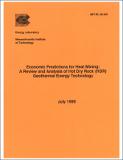| dc.contributor.author | Tester, Jefferson W. | en_US |
| dc.contributor.author | Herzog, Howard J. | en_US |
| dc.contributor.other | Massachusetts Institute of Technology. Energy Laboratory. | en_US |
| dc.date.accessioned | 2011-01-14T23:32:31Z | |
| dc.date.available | 2011-01-14T23:32:31Z | |
| dc.date.issued | 1990 | en_US |
| dc.identifier.uri | http://hdl.handle.net/1721.1/60650 | |
| dc.description.abstract | The main objectives of this study were first, to review and analyze several economic assessments of Hot Dry Rock (HDR) geothermal energy systems, and second, to reformulate an economic model for HDR with revised cost components. | en_US |
| dc.description.abstract | A general evaluation of the technical feasibility of HDR technology components was also conducted in view of their importance in establishing drilling and reservoir performance parameters required for any economic assessment (see Sections 2-5). In our review, only economic projections for base load electricity produced from HDR systems were considered. Bases of 1989 dollars ($) were selected to normalize costs. | en_US |
| dc.description.abstract | Following the evaluation of drilling and reservoir performance, power plant choices and cost estimates are discussed in Section 6. In Section 7, the six economic studies cited earlier are reviewed and compared in terms of their key resource, reservoir and plant performance, and cost assumptions. Based on these comparisons, we have estimated parameters for three composite cases. Important parameters include: (1) resource quality--average geothermal gradient (oC/km) and well depth, (2) reservoir performance--effective productivity, flow impedance, and lifetime (thermal drawdown rate), (3) cost components--drilling, reservoir formation, and power plant costs and (4) economic factors--discount and interest rates, taxes, etc. In Section 8, composite case conditions were used to reassess economic projections for HDRproduced electricity. In Section 9, a generalized economic model for HDR-produced electricity is presented to show the effects of resource grade, reservoir performance parameters, and other important factors on projected costs. A sensitivity and uncertainty analysis using this model is given in Section 10. Section 11 treats a modification of the economic model for predicting costs for direct, non-electric applications. HDR economic projections for the U.S. are broken down by region in Section 12. In Section 13, we provide recommendations for continued research and development to reduce technical and economic uncertainties relevant to the commercialization of HDR. | en_US |
| dc.format.extent | 180 p | en_US |
| dc.publisher | [Cambridge, Mass.] : Energy Laboratory, Massachusetts Institute of Technology, 1990 | en_US |
| dc.relation.ispartofseries | Energy Laboratory report (Massachusetts Institute of Technology. Energy Laboratory) no. MIT-EL 90-001. | en_US |
| dc.title | Economic predictions for heat mining : a review and analysis of hot dry rock (HDR) geothermal energy technology | en_US |
| dc.identifier.oclc | 23447456 | en_US |
